Features of the use of phosphoric acid against rust
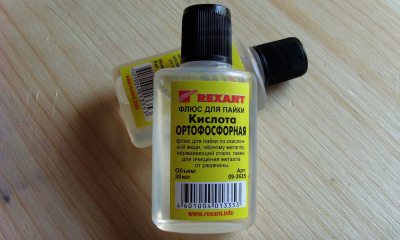 The appearance of rust on the surface of objects, dishes, equipment is an urgent problem. Phosphoric acid is often used to solve it.
The appearance of rust on the surface of objects, dishes, equipment is an urgent problem. Phosphoric acid is often used to solve it.
This inorganic compound has many advantages, but also has a number of limitations in its use.
To achieve the effect and qualitatively clean products from rusty stains and layers, you must follow the instructions for using phosphoric acid from rust.
Content
Will the remedy help?
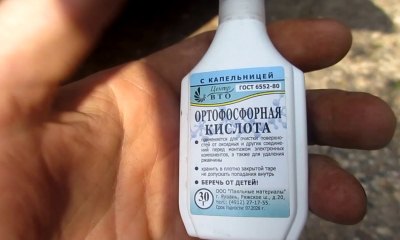 In its natural state, phosphoric acid (H3PO4) is a colorless crystal. In everyday life and industry, an 85th aqueous solution is used.
In its natural state, phosphoric acid (H3PO4) is a colorless crystal. In everyday life and industry, an 85th aqueous solution is used.
This reagent actively interacts with iron oxides and hydroxides... This explains the high efficiency of phosphoric acid in relation to rust.
The converter helps to remove corrosion deposits from metal, ceramic, faience, enamel surfaces. That is why it is advisable to use it when cleaning plumbing fixtures, kitchen utensils, industrial equipment, cars.
In some cases, the chemical is not recommended for use due to low effectiveness or limitations... The cleaner does not help if the rust layer is too thick. In such a situation, the oxidized surface is first ground and only then treated with a solution.
Phosphoric acid is not suitable for acrylic coatings.
Pros and cons of cleaning
Phosphoric acid is one of the popular and demanded rust removers.
This is due to several advantages of the reagent:
- high cleaning efficiency;
- ease of use;
- budget cost;
- wide range of applications.
However, when using this inorganic substance, a number of negative aspects come to light. The existing disadvantages limit the use of the converter and force you to remember the precautions.
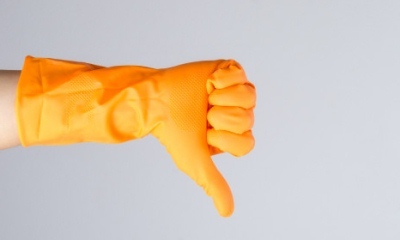 The most important disadvantages are:
The most important disadvantages are:
- Acid and its vapors can irritate mucous membranes, respiratory tract, eyes.
- If a pure substance accidentally gets into the stomach, nausea, vomiting, and diarrhea occur.
- Possible holes when cleaning very thin items from rust.
- Cannot be used to remove rust from objects covered with acrylic.
How to dilute and use to remove rusty deposits: instructions
The acid goes on sale at a concentration of 85%. If only reagent powder is available, dilute it with water in a ratio of 1: 5 or 1: 6.
To use concentrated phosphoric acid on rust stains, you must first prepare a working solution.
Further, to remove corrosion traces, one of two methods is used: immersion in a transducer or applying a solution to the surface.
Immersion cleansing
For small items, the best way to completely immerse in phosphoric acid. Detailed instructions require compliance with step-by-step actions:
- the item is cleaned and degreased with a detergent and rinsed with water;
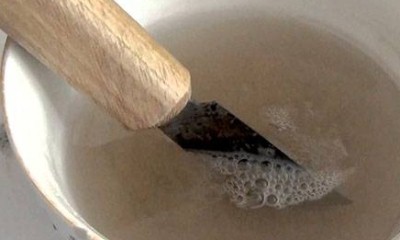 85% reagent is diluted in a large container in a proportion of 100-150 g per 1 liter of water;
85% reagent is diluted in a large container in a proportion of 100-150 g per 1 liter of water;- a rusty product is placed in the prepared liquid for one hour;
- during soaking, the object is periodically moved or turned over;
- take out a thing and rinse under running clean water;
- prepare a neutralizer from water (50%), butyl alcohol (48%) and ammonia (2%);
- the product is wiped with an alcohol solution, washed with water and dried.
Each stage of the work is important, so ignoring it can worsen the result. In order not to clean the surface twice, it is recommended to follow the instructions exactly.
To enhance the effect and obtain a strong protective layer, a special inhibitor "Catapin" is added to the acidic liquid (1-2 grams per liter of solution). The additive slows down the process of interaction with unoxidized metal.
Surface application
This method is used in two cases.
- Firstly, if a large product is covered with rust, for which it is not possible to use the immersion method.
- Secondly, if there is not enough phosphoric acid available to fill a large container.
The cleaning technique consists of several sequential steps:
- the area with rust is washed with a detergent;
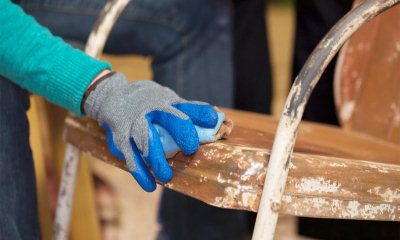 preparing a working solution of phosphoric acid;
preparing a working solution of phosphoric acid;- the converter is applied to the surface of the product;
- stand for two hours to complete the reaction;
- wash the surface with water and dry slightly;
- prepare a neutralizing solution from water and alcohols;
- wipe the cleaned area with a neutralizer;
- rinse again with water and wipe dry.
In this way, they are cleaned of rusty spots:
- home plumbing,
- tile,
- cast iron boilers,
- pipes,
- heating radiators,
- non-removable car parts.
Dilution of the acid and neutralizing solution is carried out according to the same scheme that is used in the immersion method.
Surface Treatment Precautions
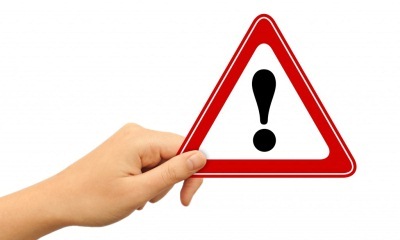 In small amounts and in a diluted state, phosphoric acid does not show toxicity. This substance is approved for addition to food. It is present, for example, in the composition of Coca-Cola.
In small amounts and in a diluted state, phosphoric acid does not show toxicity. This substance is approved for addition to food. It is present, for example, in the composition of Coca-Cola.
but when working with a pure reagent or a high concentration solution, safety measures must be observed... Orthophosphoric acid is an aggressive substance that irritates the integument, eyes, respiratory and digestive organs.
In extreme cases, burns and poisoning are possible.If the concentrated converter comes into contact with the skin or eyes, immediately flush the contact areas with plenty of water or saline. Do not wipe the skin with napkins or a towel, as this will increase the penetration of the substance into the tissues.
If the damage is severe and causes pain, then an anesthetic drug is taken to alleviate the well-being... If liquid gets inside, first aid to a person before being examined by a doctor is to support breathing and drink plenty of fluids. If the acid is spilled, then it is neutralized with alkaline solutions.
Tips on the topic of the article
To speed up the cleaning process and facilitate the work, it is recommended to take into account the degree of corrosion, the nature of the surface and other nuances.
Experts advise:
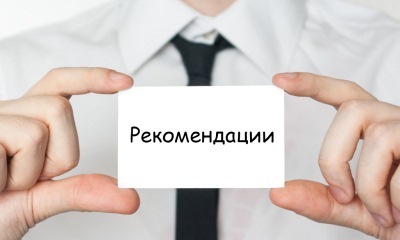 Before using a chemical cleaner, it is advisable to first clean a significant layer of rust with coarse sandpaper, a metal brush, a knife or a grinder.
Before using a chemical cleaner, it is advisable to first clean a significant layer of rust with coarse sandpaper, a metal brush, a knife or a grinder.- If the surface after cleaning is planned to be coated with varnish or paint, then it is advisable to use not a pure acid solution, but a factory phosphoric converter containing additional ingredients.
- With the surface method, the solution is applied only to the corroded area. To protect the intact coating around the stain, cover it with plastic wrap.
- When carrying out the cleaning procedure in the apartment, it is necessary to turn on the ventilation and open the windows.
- Before and after use, the phosphoric acid powder and liquid should be stored in hermetically sealed containers at room temperature, on shelves inaccessible to children.
Useful video
The video will tell you how to remove rust stains with phosphoric acid:
Conclusion
Phosphoric acid is an excellent product for removing rust marks on various surfaces. To obtain the desired effect, it is necessary to choose a suitable method of cleaning and strictly follow the instructions for use of the converter. In any case, working with a chemical requires compliance with safety rules.
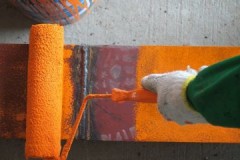
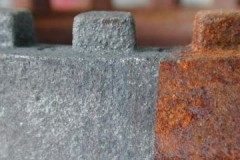
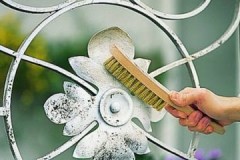
 Cleaning
Cleaning Wash
Wash Ironing
Ironing Technics
Technics Cleaning products
Cleaning products Storage and care
Storage and care